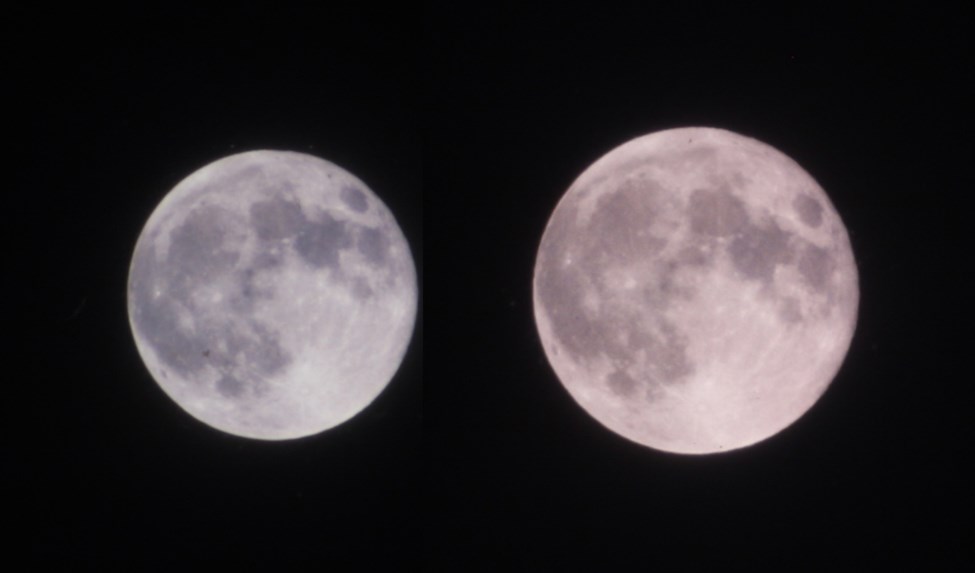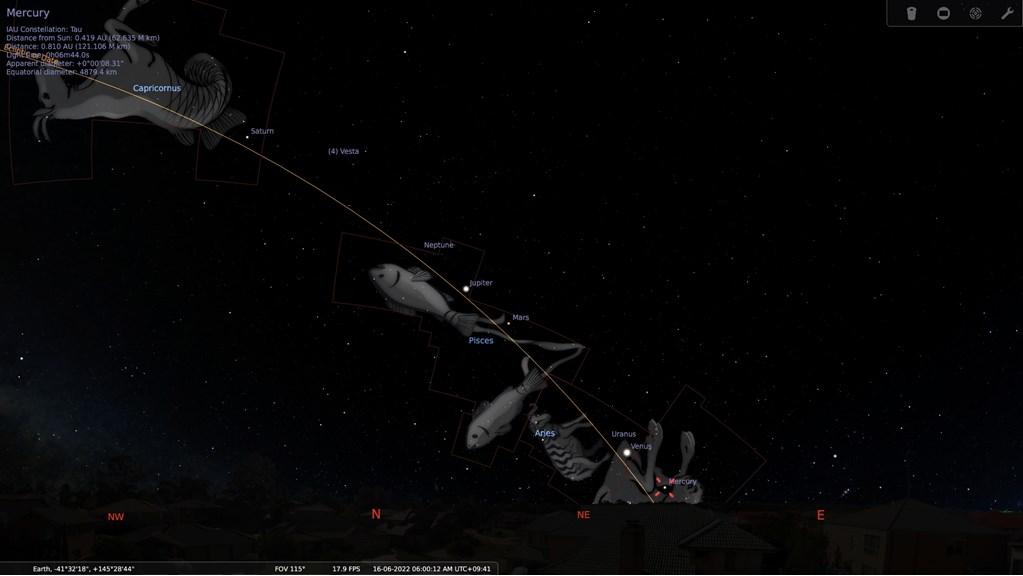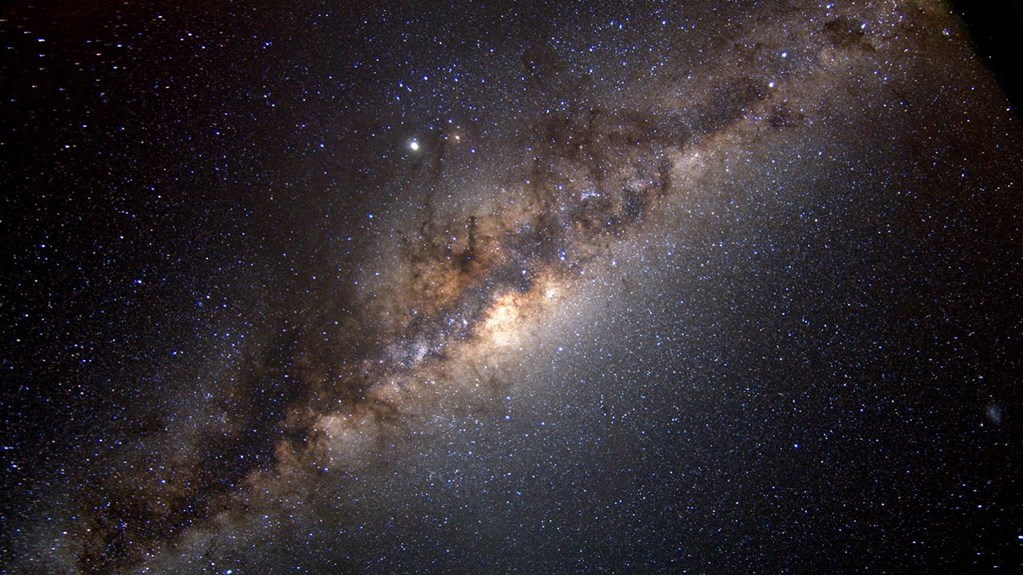Skynotes: June 2022
Upcoming events
Winter Solstice
This month on the 21st we will reach Winter Solstice in the southern hemisphere. On that day the sun rises and sets at its most northerly points on the eastern and western horizons, its daytime path across the sky is lowest and shortest, and we therefore experience the shortest day and longest night of the year.
Winter and summer solstices, and the spring and autumn equinoxes, result from the tilt of Earth’s rotational axis which sits at an angle of 23.5 degrees from the plane of our orbit around the Sun.
Full Moon at perigee
On the night of June 14th-15th we will have a larger and brighter than average full moon, often referred to as a “super moon”. The moon will be at its closest to Earth for the month (perigee) which will also coincide with the moon being opposite the sun from us which will make the entire sunlit side of the lunar surface visible (a full moon).
The perigee full moon in a clear sky will be about 14% larger and perhaps 30% brighter than a full moon at apogee when our neighbour is furthest from Earth, a so called “micromoon”. The difference in the moon’s distance at maximum apogee compared to maximum perigee is a little over 42,000km which results in a noticeable difference in size and brightness.
However, at full moon or other phases too, we often experience ‘moon illusions’. When close to the horizon our neighbour will seem larger than when higher in the sky. Several factors seem to influence our viewing of the moon.
We sense the sky as a dome above our heads and mentally place the moon on this imaginary bowl. Perceptions, however, can often be affected by comparisons we make. Our clever but misleading brains see the moon low in the sky and judge it against large familiar things such as the horizon, hills, buildings or trees which are relatively close, whereas with the moon high in the sky we have no such objects to compare it to and so perceive it as further away and smaller. Another factor that may well apply is the fact that light from the moon when close to the horizon travels through a thick horizontal layer of atmosphere before reaching our eyes which creates more atmospheric distortion and moonglow compared to a thin vertical layer above us when the moon is overhead.
Learn more at
Five visible planets this month
Last month we enjoyed four planets together, but this month all five visible planets can be seen at once from early rising Saturn, followed by Jupiter, Mars, Venus and lastly Mercury just before dawn.
If you watch over several nights from the 18th onwards the Moon will appear to move night by night through the planetary line up as it transitions through Third Quarter phase to New Moon on the 24th.
Here is a Stellarium view of the five visible planets for 6am on June 16th looking across the sky. Saturn is high in the north-west in Capricorn. Jupiter and Mars are lower in the north in Pisces. In the north-east sits bright Venus in Aries and close to the horizon is Mercury in Taurus (which lies mostly below the horizon). The ecliptic is the yellow line close to or along which all the planets are situated.
As in last month’s view Vesta, the second largest object in the asteroid belt is marked again, as is Neptune, but this month Uranus joins the line- up. None of these would be visible with the unaided eye, however, if you had a telescope and a clear night away from light pollution you might capture seven planets in one go!
Melbourne Sun times
| Date | Rise | Solar noon§ | Set | Day length |
|---|---|---|---|---|
| Wed 1st | 7.26am | 12.17pm | 5.09pm | 9.42hrs |
| Sat 11th | 7.32am | 12.19pm | 5.07pm | 9.35hrs |
| Tue 21st | 7.35am | 12.21pm | 5.08pm | 9.32hrs |
| Wed 30th | 7.34am | 12.23pm | 5.11pm | 9.34hrs |
§ When the sun is at its highest, crossing the meridian or local longitude.
Moon phases
| Phase | Date |
|---|---|
| First Quarter | Wed 8th |
| Full Moon | Tue 14th |
| Third Quarter | Tue 21st |
| New Moon | Wed 29th |
Moon distances
Wed 29th is lunar apogee (furthest from Earth) at 406,580 km.
Wed 15th is lunar perigee (nearest to Earth) at 357,432 km.
Planets
Mercury will at last become into view from mid-month when it will rise just before dawn from around 5.30am when it will join the other four visible planets in a wonderful line up in the north eastern to northern skies.
Venus is drawing closer to the north-eastern horizon but is easily seen as the brightest object in the night sky, second only to moon. It can be seen rising from 4.30am early in June and from 5am later in the month before fading in the dawn light.
Earth has its June or mid-year solstices this month; winter solstice for the southern hemisphere and summer solstice for the northern hemisphere. The sun makes its most northerly, shortest and lowest daily path in the sky reaching its winter limit as seen from the southern hemisphere. On this shortest day of the year, the sun’s rays reach the ground at their shallowest angle (hence long shadows) and give the least energy per square metre.
Solstice comes from the Latin sol (sun) and sistere (stand still). On the day of the solstice the Sun is said to briefly “stand still” as it reaches its northern extreme rising and setting points. After the 21st it resumes daily shifts but reversing with rising and setting a little further south each day and a slowly lengthening daytime path as we move to spring equinox and eventually summer solstice.
Mars rises around 2am early in June and by 3am later in the month, before reaching a high point in the north and then fading from view well before dawn.
Jupiter can easily be seen rising from 1.30am early in June and gradually later in the month. It will progressively appear higher in the north each night before becoming lost by dawn. The positions of Jupiter and Mars swap this month with the Red Planet drawing down to the horizon while the Jovian Giant rises higher.
Our Earth-based perspective looking out across the solar system regularly gives us interesting examples of how planets appear to switch positions in our night skies. This planetary ‘dance’ reflects two underlying aspects of our solar system as witnessed from Earth; firstly, the fact that the inner planets Mercury, Venus and Mars move faster around the sun compared to the slower outer planets Jupiter and Saturn, and secondly, where the planets happen to be in their respective orbits around the sun.
As mentioned earlier, this month our night time line of sight, or broad viewing angle from east to northwest, captures all five visible planets.
Saturn in June will rise just before midnight and rise high in the north, but by end of the month it will rise significantly earlier at around 9.30pm. It’s yellowish tinge should make it reasonably easy to spot as it leads the other planets until it too fades well before dawn.
Meteors
There are minor meteor showers this month centred in Scorpius and Sagittarius, and The Bootids can also appear from very late June into early July. Although low in number (less than 10 per hour) they can often be spectacular and bright with many displaying a yellow/orange colour. The best time to see meteors is after midnight with no moon in the night sky.
Stars and constellations
In the west
While Orion disappears below the western horizon (with the ‘Saucepan’ asterism), his two dogs Canis Major with the star Sirius and Canis Minor with the star Procyon both remain visible in the west and north-west respectively.
In the north
Leo the lion is still visible in the north with the bright star Regulus. Look for a large hook of stars, or inverted question mark, to locate his curving mane and shoulders.
In the east
This month Scorpius is fully visible in the south-east with the red-giant star Antares as the middle of three stars that form the scorpion’s body. As we enter winter Sagittarius the archer begins to rise in the east after Scorpius with the centaur’s bow and arrow also the famous ‘Tea Pot’ asterism leading the way.
In the south
The Southern Cross or Crux is high in the south this month with the Pointers (Alpha and Beta Centauri) a little lower down in the south-east. Visible from darker locations are the two neighbouring galaxies that sit as two small fuzzy patches in the south-west, the Large and Small Clouds of Magellan. For viewers in our southern latitudes they are a special sight as they cannot be seen from equivalent latitudes in the northern hemisphere.
Also visible in the evening in less light-polluted skies sits the broad band of the Milky Way stretching across the sky from south-east to north-west. This concentration of hundreds of billions of stars also contains numerous interstellar dust clouds which appear as dark areas. We see small numbers of foreground stars but beyond them the dark clouds block out more distant stars of the galaxy.
International Space Station
ISS orbits every 90 minutes at an average distance of 400 km appearing like a bright star moving slowly across the night sky. Here are some of the brightest passes expected this month over Melbourne and Central Victoria:
Morning
Tue 7th 6:32am-6.38am South-West to North-East
Fri 10th 5:47am-5:50am North-North-West to North-East
Evening
Sun 19th 6:21pm-6:26pm North-West to East-South-East
Wed 22nd 5:32pm-5:39pm North-West to South-East
Heavens Above gives predictions for visible passes of space stations and major satellites, live sky views and 3D visualisations. Be sure to first enter your location under ‘Configuration’.
On this day
1st 2002, Czech Republic becomes the first country to ban light pollution.
2nd 1966, Surveyor 1 (USA) reaches the Moon as first probe to land on another body.
3rd 1965, Ed White takes America’s first spacewalk as part of Gemini IV.
6th 1971, Soyuz 11 (‘Union’ 11, USSR) carries the first people to a space station (Salyut 1 or ‘Salute’ 1).
7th 1879, Joan Voute proves with parallax that dwarf star Proxima Centauri is the same distance as Alpha Centauri binary.
8th 2004, a Transit of Venus is observed, the first in 122 years.
9th 1986, Rogers report on Space Shuttle Challenger explosion reveals solid rocket booster fault and serious management and safety problems with US program.
10th 2003, launch of Mars Exploration Rover Spirit (USA) which lands in 2004 and exceeds expectations operating to 2010.
13th 1983, Pioneer 10 (USA) becomes the first spacecraft to travel beyond the planets of the Solar System.
13th 2010, Hyabusa (Japan) craft returns the first asteroid samples to Earth.
14th 1962, European Space Research Organisation (ESRO) begins, later to be part of the European Space Agency (ESA).
15th 763 BCE, Assyrians record a total solar eclipse which helps date other events in Mesopotamian history.
16th 1911, a meteorite weighing 772g strikes a barn in rural Wisconsin (USA).
16th 1963, Valentina V. Tereshkova (USSR) becomes the first woman in space in Vostok 6, the first civilian into space, and the only woman to undertake a solo space flight.
17th 1969, Venera 6 (‘Venus 6’, USSR) descends into Venus’ dense atmosphere sending data before being crushed by rising pressure.
18th 1983, Sally Ride becomes the first American woman in space aboard Shuttle Challenger.
20th 1990, Asteroid Eureka found as part of the Trojans asteroid group orbiting at Mars’ L5 Lagrange point.
21st 2004, SpaceShipOne (USA) is launched as the first privately-funded human space flight.
21st 2006, Pluto’s small moons Nyx and Hydra are named.
22nd 1633, Galileo recants his sun-centred solar system model under threat of torture by the Catholic Inquisition.
22nd 1978, Dr James W. Christy (USA) discovers Pluto’s large moon Charon.
24th 1883, discoverer of cosmic rays, Victor Francis Hess, is born.
24th 1915, birth of Fred Hoyle, who later explains the creation of elements in stars, promotes the steady state model of the universe, and coins the pejorative term ‘big bang’ for the rival model of the universe’s creation.
24th 1997, first life-threatening space collision occurs as Russia’s Progress supply craft collides with Mir Space Station during a test docking while not using its automated docking and radar system. The ageing problem-plagued station suffers a 3cm puncture in its Spekr module which quickly depressurises. US astronaut Mike Foale evacuates from the damaged module in time and Mir spins out of control as solar power is lost. Progress rebounds but is later safely de-orbited to burn up. Control is slowly regained by cosmonaut Vasily Tsbliev assisted by cosmonaut Aleksander Lazitkin and Foale. This serious incident heightens tensions between the American space agency NASA and their Russian counterpart Roscosmos.
29th 1818, Angelo Secchi born, one of the first astronomers to believe the Sun is a star.
29th 1961, first use in space of a radioisotope thermoelectric generator (RTG) using plutonium238 which powered a US Navy NAVSAT satellite Transat4A.
29th 1995, Space Shuttle Atlantis (USA) – first docking at Russia’s Mir Space Station.
30th 1908, The Tunguska Event; a meteor several metres in size explodes over Tunguska (Russia) destroying 2,200 km2 of forest in a multi-megaton blast.
30th 1971, Soyuz 11 (USSR) is the only mission to visit the first space station Salut 1 (USSR) after which its crew of three become the only humans known to have died in space when their cabin depressurises prior to or during re-entry.



